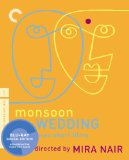| Reviews & Columns |
|
Reviews DVD TV on DVD Blu-ray 4K UHD International DVDs In Theaters Reviews by Studio Video Games Features Collector Series DVDs Easter Egg Database Interviews DVD Talk Radio Feature Articles Columns Anime Talk DVD Savant Horror DVDs The M.O.D. Squad Art House HD Talk Silent DVD
|
DVD Talk Forum |
|
|
| Resources |
|
DVD Price Search Customer Service #'s RCE Info Links |
|
Columns
|
|
|
Monsoon Wedding - Criterion Collection
The Criterion Collection // R // October 20, 2009
List Price: $39.95 [Buy now and save at Amazon]
The Film:
Mira Nair's Monsoon Wedding is an experience in every sense of the word, capturing the subtle memories, unforeseen excitement, and the ups and downs of real life while showcasing a rally of heartening moments. It takes an intimate look at the interworking parts of a wedding ceremony, from the father's bickering with the organizer to the shades of doubt between the husband and wife days before, while making us feel like a fly on the wall instead of a mere witness to a story. This, on the other hand, is a different sort of wedding than many might be used to, an arranged marriage in modern time between two Indian families with a long history. Within that combination of realism and lingering cultural poignancy, we take a beautiful trip through the complications and joys surrounding this family, coming together in a vivid and blissful event that would likely get a smile out of even the most melancholy film lovers.
Written by Sabrina Dhawan to emphasize minor elements and the simple joys of interaction just as much as the bold and boisterous, Monsoon Wedding focuses on father Lalit Verma (Naseeruddin Shah) and his four day scramble to throw together a lush and expensive wedding for his daughter Aditi (Vasundhara Das), an event that will bring the entire family together under one roof. Her arranged marriage, carried through with a man she hadn't known for very long, is awkward for Aditi due to her lingering feelings for a married television host, a man whom she's shared a physical relationship with in the past.
Underneath the bedlam of constructing this ceremony, Murphy's Law comes into full effect as several other family woes come to the surface. The relationship between Lalit's niece Ria (Shefali Shetty) and her wealthy uncle-in-law -- a man who has provided generous funds to the family -- slowly simmers due to his offer to fund her education. A disagreement intensifies between Lalit and his son Valum, a kid who's more interested in dance choreography and cooking instead of being a "real" Punjabi man. Furthermore, a lingering attraction between Lalit's Australian-based nephew and Aditi's young female cousin rises up after some flirtation. You know, the "typical" dirty laundry to come out of the woodwork around any kind of family reunion, though it grows thicker and thicker as the date approaches.
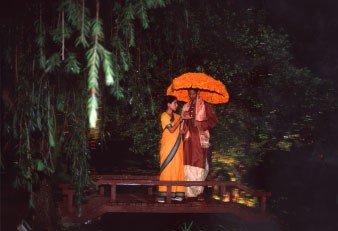 At the heart of Monsoon Wedding lies a story we've heard before, one featuring cold feet and fleeting desires from a soon-to-be-married person wanting to indulge in past amorous urges for a loved one. It's a cliché plot device that's been played out in even the sappiest of romantic films, yet director Mira Nair never causes us to dwell on that for one second. Her handling of the material paints a superb picture teeming with tangible emotion and meditation, giving us a struggle within Aditi's woeful mindscape. Her downhearted attitude detaches her from the family to a degree -- especially to her father -- which arouses trepidation in our emotional investment with her character; however, as the film progresses and we develop a stronger grasp on both her concern and her family's multifaceted connections, their actions and external reactions begin to balance out our reservations and earn our appreciation.
At the heart of Monsoon Wedding lies a story we've heard before, one featuring cold feet and fleeting desires from a soon-to-be-married person wanting to indulge in past amorous urges for a loved one. It's a cliché plot device that's been played out in even the sappiest of romantic films, yet director Mira Nair never causes us to dwell on that for one second. Her handling of the material paints a superb picture teeming with tangible emotion and meditation, giving us a struggle within Aditi's woeful mindscape. Her downhearted attitude detaches her from the family to a degree -- especially to her father -- which arouses trepidation in our emotional investment with her character; however, as the film progresses and we develop a stronger grasp on both her concern and her family's multifaceted connections, their actions and external reactions begin to balance out our reservations and earn our appreciation.
Interestingly, Monsoon Wedding's more robust connections come in an array of densely emotional sub-layers underneath the paramount wedding narrative. Though Aditi's woes are motivation enough to latch onto the film, it's hard to ignore the overwhelming potency behind Ria's role in the family chaos. Played wonderfully by Shefali Shetty, her character undergoes a bombardment of draining complications involving her family, from emptiness regarding the absence and tragedy revolving around her mother and father to her complicated past with her uncle-in-law. A second, more purist romance ignites between the unsuccessful-in-love wedding coordinator P.K. and the Latit family servant Alice -- which shines an evocative spotlight on the link between the two that's cheeky, humorous, and highly satisfying. We assume that the wedding coordinator will be a one-dimensional worm-like entity, yet his evolution -- and that of the servant -- can be quite touching. Their connection becomes the pure thumping heart in Monsoon Wedding, especially as P.K. and Alice grow closer and their glances grow deeper.
Mira Nair's ace in the hole in Monsoon Wedding comes in her capacity to render exquisite male characters, showcasing a sharp eye for intensity in their mannerisms. Her handling of women, especially Ria, is exceptional as well, yet there's a specific level of panache in the ways that she projects the Punjabi masculinity that's stellar. Her technique is especially visible with Naseeruddin Shah's impressive portrayal as the family patriarch Lalit, a strong and driven man who struggles with financial issues during the wedding and raising his children. His energy can be felt from frame to frame, whether he's bickering with the slimy wedding coordinator (slimy in his eyes, yet he's starting to warm to ours) or attempting to instruct his misguided son.
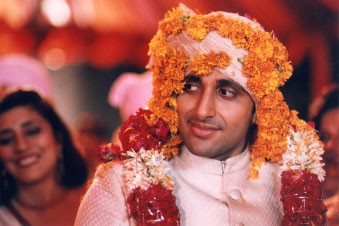 Monsoon Wedding has a lot in common with Jonathan Demme's 2006 independent success Rachel Getting Married, both in concentration of meaningless yet endearing personal dialogue and in the flowing visual design that follows their interactions -- and there's a reason for it. Both films were captured by cinematographer Declan Quinn, something that becomes readily obvious by watching even short spans of their work. However, he's encouraged to be much more poetic and creative with his visuals in Mira Nair's film, focusing on the blistering colors of marigolds and the swirling majesty of an Indian dance in rapturous fashion. It's a more elegiac experience which, without question, connects deeper with our senses as we're carried through the warming narrative.
Monsoon Wedding has a lot in common with Jonathan Demme's 2006 independent success Rachel Getting Married, both in concentration of meaningless yet endearing personal dialogue and in the flowing visual design that follows their interactions -- and there's a reason for it. Both films were captured by cinematographer Declan Quinn, something that becomes readily obvious by watching even short spans of their work. However, he's encouraged to be much more poetic and creative with his visuals in Mira Nair's film, focusing on the blistering colors of marigolds and the swirling majesty of an Indian dance in rapturous fashion. It's a more elegiac experience which, without question, connects deeper with our senses as we're carried through the warming narrative.
It's all cradled within a story that's able to be told in a moment's length, yet the way in which we're seeped in New Delhi culture and expressive, heart-on-the-sleeve emotional resonance incenses our cinematic pleasures in a trove of different ways. We're given beauty from start to finish in Monsoon Wedding, bustling along and brimming with splendor in a way that appeal to both visual and cultural pleasures. Between a few splendid dance sequences -- one lengthy stretch near the conclusion that's particularly entrancing -- and the consistent stream of poeticism behind its graceful flow, I can't help but be utterly mesmerized by its fluid execution. Especially at the conclusion, which shines with undeniable jubilation at the celebration of life and family. Since her achievement with the Verma family, Mira Nair has gone on to piece together another cultural assimilation picture with 2006's The Namesake, a picture that's potentially more than the dramatic equal to her Venice prize-winning wedding tale; however, drenched in pure goodness and emerald-bathed beauty, Monsoon Wedding's splendor still stands proud as her most vivacious and lyrical work.
The Blu-ray:
Criterion's presentation continues their new clear-case presentations with Monsoon Wedding, spine #489, showcasing artwork that reflects the simple curly-cue design of the title credits on both the outside and the inside. Within, a thick Booklet is made available that discusses the short films and Criterion's mastering process. Also inside of the booklet is a lengthy essay entitled "A Marigold Tapestry", by Pico Iyer.
Video and Audio:
Criterion have done an exceptional job with their high-definition releases so far, ranging from strong renderings of uncooperative source material in El Norte and Chungking Express to simply stunning projection of lurid cinematography with In the Realm of the Senses. Monsoon Wedding, though carrying beautiful cinematography of some rather sumptuous visuals, suffers in the fashion of the first group mentioned in that the film was shot using 16mm cameras and blown up to a 35mm print. As a result, Criterion have used their Spirit Datacine process from the original 16mm negative and cleaned the image up with their regular mix of dirt/debris removal, and the result is a highly impressive rendering of Declan Quinn's photography.
Green shades mostly dominate the exterior shots, looking sumptuous in each one. Detail is naturally restricted due to the limited capacity of the negative, which makes for slightly blurry distanced shots when looking closely. Also, the colors fluctuate just a bit due to the heavier grain present, flickering slightly in some shots but never crippling skin tonality. However, these are all minor carps on a tremendously beautiful image, one that emphasizes focus depth and vividness to exceptional levels. Though limited, some of the details can really surprise, like the petals on the marigolds that P.K. eats and the dense number of people crammed into New Delhi's streets. As the photography approaches nighttime, we're treated to inky, natural black levels and naturally heightened film grain, nothing that ever approaches excessive levels. As a whole, it's about the best Monsoon Wedding will ever look, and another top-shelf effort from Criterion in the image department.
On the aural front, we've also got a DTS HD Master Audio track that keeps speed extremely well with the image. Mastered at 24-bit from the original strips, it's largely a front-heavy presentation that focuses on dialogue clarity and richness of native ambiance. Elements like honking horns, ruffling of flowers and, naturally, the falling of rain carry a strong grasp of the space around them -- sounding innate and very pleasing. Verbal clarity, switching between English and Indian languages, always carries a sleek naturalness that rarely, if ever, grows remotely thin or metallic. Surround channels are used carefully and largely for an enveloping musical experience, only floating elements back when it's absolutely necessary. It's a rich soundtrack void of any problematic distortion or quirks in its flow. Subtitles appear in strong white-face font near the lower portion of the screen, translated well to the English language (the only option).
Seven Short Films by Mira Nair:
Each one of Mira Nair's seven short films are accompanied by introductions from the director, sharing anecdotes about the process of making each film. All of these features are available in HD AVC encodes, looking mostly good for their age. It's easy to see Mira Nair's documentarian style translate to non-documentaries and, then, to full-length by watching these pieces, as they all carry a similar lingering nature about their close-ups and movement. Note that all of the short features are available in the "Short Films" tab instead of Laughing Club of India, which is available in the Special Features tab.
Special Features:
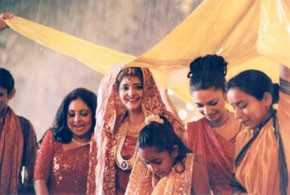 Audio Commentary with Mira Nair:
Audio Commentary with Mira Nair:
Recorded in 2002, this commentary is likely the track used for previous versions of the film. It gives a bit of history regarding the director, Punjabi work (and party) ethics, and history behind hiring each of the actors. She stays extraordinarily on-task, revealing much about the internal layers, her thoughts about the individualized relationships, and shooting on a tight schedule. It's a very rewarding track with few patches of silence, staying earnest and warm about her insight and about the parallels and assimilation of New Delhi culture to a more modernized paradigm. One of my favorite portions of the commentary focuses on the loss of footage, as well as how they used the damaged prints as a "happy accident" to fill in gaps.
Mira Nair Interviews Naseeruddin Shah (21:24, HD AVC):
One of the more rewarding experience come when a director pries her actors in interview time, and this interview time with the star and director of Monsoon Wedding continues that feeling. Nair and Shah share a myriad of stories, staying very pleasant about their reflections on starting the film, working on a small budget, and the "moments" in Punjabi weddings. As the conversation continues, they eventually get around to discussing Naseeruddin Shah and his evolution as an actor.
Declan Quinn and Stephanie Carroll(10:35, HD AVC):
Takinga similar dynamic, the cinematographer and production designer discuss their excursions in giving Monsoon Wedding its beautiful look. It points out some key visual cues that some might oversee for a few sequences, as well as pre-production and operating the camera. There are a few gaps of behind-the-scenes footage incorporated in this piece which are worth seeing as well.
To round everything out, we've got a Theatrical Trailer (2:22, HD AVC) which paints up the film extremely well -- as well as offers a number of scenes that can be compared with Criterion's visual treatment to see the boost in quality.
Final Thoughts:
Monsoon Wedding is magnificent. Beautifully photographed and exceptionally written with joy in its heart, Mira Nair's semi-documentary style love letter to Indian culture pulsates with inextinguishable charisma. Though several layers are draped atop each other amid the bustling nature of constructing this meaningful, lavish wedding, it's the straightforward resonance pouring from its bright, hopeful nature that makes it splendidly enjoyable. It's also meaningful underneath its charm, carrying a deeper side as the family relationships begin to unfurl right before the film approaches its uplifting climax.
Nair's The Namesake may make for a more dramatically meaningful film about the assimilation between Indian and modern culture, but Monsoon Wedding's gorgeous visuals and raw emotional projection is simply entrancing. Criterion's Blu-ray presentation heightens this pure beauty with a gorgeous visual transfer and enveloping audio -- as well as a delightful cluster of extras, including seven of Mira Nair's short features. It's a Highly Recommended Blu-ray presentation of a glowing film, one that shouldn't be missed.
Thomas Spurlin, Staff Reviewer -- DVDTalk Reviews | Personal Blog/Site
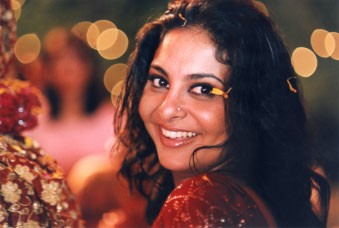 |
Written by Sabrina Dhawan to emphasize minor elements and the simple joys of interaction just as much as the bold and boisterous, Monsoon Wedding focuses on father Lalit Verma (Naseeruddin Shah) and his four day scramble to throw together a lush and expensive wedding for his daughter Aditi (Vasundhara Das), an event that will bring the entire family together under one roof. Her arranged marriage, carried through with a man she hadn't known for very long, is awkward for Aditi due to her lingering feelings for a married television host, a man whom she's shared a physical relationship with in the past.
Underneath the bedlam of constructing this ceremony, Murphy's Law comes into full effect as several other family woes come to the surface. The relationship between Lalit's niece Ria (Shefali Shetty) and her wealthy uncle-in-law -- a man who has provided generous funds to the family -- slowly simmers due to his offer to fund her education. A disagreement intensifies between Lalit and his son Valum, a kid who's more interested in dance choreography and cooking instead of being a "real" Punjabi man. Furthermore, a lingering attraction between Lalit's Australian-based nephew and Aditi's young female cousin rises up after some flirtation. You know, the "typical" dirty laundry to come out of the woodwork around any kind of family reunion, though it grows thicker and thicker as the date approaches.
 At the heart of Monsoon Wedding lies a story we've heard before, one featuring cold feet and fleeting desires from a soon-to-be-married person wanting to indulge in past amorous urges for a loved one. It's a cliché plot device that's been played out in even the sappiest of romantic films, yet director Mira Nair never causes us to dwell on that for one second. Her handling of the material paints a superb picture teeming with tangible emotion and meditation, giving us a struggle within Aditi's woeful mindscape. Her downhearted attitude detaches her from the family to a degree -- especially to her father -- which arouses trepidation in our emotional investment with her character; however, as the film progresses and we develop a stronger grasp on both her concern and her family's multifaceted connections, their actions and external reactions begin to balance out our reservations and earn our appreciation.
At the heart of Monsoon Wedding lies a story we've heard before, one featuring cold feet and fleeting desires from a soon-to-be-married person wanting to indulge in past amorous urges for a loved one. It's a cliché plot device that's been played out in even the sappiest of romantic films, yet director Mira Nair never causes us to dwell on that for one second. Her handling of the material paints a superb picture teeming with tangible emotion and meditation, giving us a struggle within Aditi's woeful mindscape. Her downhearted attitude detaches her from the family to a degree -- especially to her father -- which arouses trepidation in our emotional investment with her character; however, as the film progresses and we develop a stronger grasp on both her concern and her family's multifaceted connections, their actions and external reactions begin to balance out our reservations and earn our appreciation. Interestingly, Monsoon Wedding's more robust connections come in an array of densely emotional sub-layers underneath the paramount wedding narrative. Though Aditi's woes are motivation enough to latch onto the film, it's hard to ignore the overwhelming potency behind Ria's role in the family chaos. Played wonderfully by Shefali Shetty, her character undergoes a bombardment of draining complications involving her family, from emptiness regarding the absence and tragedy revolving around her mother and father to her complicated past with her uncle-in-law. A second, more purist romance ignites between the unsuccessful-in-love wedding coordinator P.K. and the Latit family servant Alice -- which shines an evocative spotlight on the link between the two that's cheeky, humorous, and highly satisfying. We assume that the wedding coordinator will be a one-dimensional worm-like entity, yet his evolution -- and that of the servant -- can be quite touching. Their connection becomes the pure thumping heart in Monsoon Wedding, especially as P.K. and Alice grow closer and their glances grow deeper.
Mira Nair's ace in the hole in Monsoon Wedding comes in her capacity to render exquisite male characters, showcasing a sharp eye for intensity in their mannerisms. Her handling of women, especially Ria, is exceptional as well, yet there's a specific level of panache in the ways that she projects the Punjabi masculinity that's stellar. Her technique is especially visible with Naseeruddin Shah's impressive portrayal as the family patriarch Lalit, a strong and driven man who struggles with financial issues during the wedding and raising his children. His energy can be felt from frame to frame, whether he's bickering with the slimy wedding coordinator (slimy in his eyes, yet he's starting to warm to ours) or attempting to instruct his misguided son.
 Monsoon Wedding has a lot in common with Jonathan Demme's 2006 independent success Rachel Getting Married, both in concentration of meaningless yet endearing personal dialogue and in the flowing visual design that follows their interactions -- and there's a reason for it. Both films were captured by cinematographer Declan Quinn, something that becomes readily obvious by watching even short spans of their work. However, he's encouraged to be much more poetic and creative with his visuals in Mira Nair's film, focusing on the blistering colors of marigolds and the swirling majesty of an Indian dance in rapturous fashion. It's a more elegiac experience which, without question, connects deeper with our senses as we're carried through the warming narrative.
Monsoon Wedding has a lot in common with Jonathan Demme's 2006 independent success Rachel Getting Married, both in concentration of meaningless yet endearing personal dialogue and in the flowing visual design that follows their interactions -- and there's a reason for it. Both films were captured by cinematographer Declan Quinn, something that becomes readily obvious by watching even short spans of their work. However, he's encouraged to be much more poetic and creative with his visuals in Mira Nair's film, focusing on the blistering colors of marigolds and the swirling majesty of an Indian dance in rapturous fashion. It's a more elegiac experience which, without question, connects deeper with our senses as we're carried through the warming narrative. It's all cradled within a story that's able to be told in a moment's length, yet the way in which we're seeped in New Delhi culture and expressive, heart-on-the-sleeve emotional resonance incenses our cinematic pleasures in a trove of different ways. We're given beauty from start to finish in Monsoon Wedding, bustling along and brimming with splendor in a way that appeal to both visual and cultural pleasures. Between a few splendid dance sequences -- one lengthy stretch near the conclusion that's particularly entrancing -- and the consistent stream of poeticism behind its graceful flow, I can't help but be utterly mesmerized by its fluid execution. Especially at the conclusion, which shines with undeniable jubilation at the celebration of life and family. Since her achievement with the Verma family, Mira Nair has gone on to piece together another cultural assimilation picture with 2006's The Namesake, a picture that's potentially more than the dramatic equal to her Venice prize-winning wedding tale; however, drenched in pure goodness and emerald-bathed beauty, Monsoon Wedding's splendor still stands proud as her most vivacious and lyrical work.
The Blu-ray:
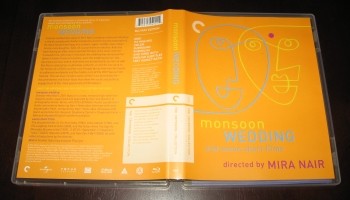 | 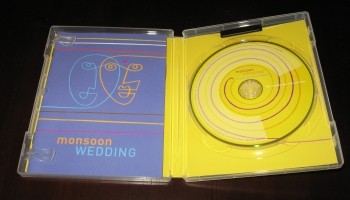 |
Criterion's presentation continues their new clear-case presentations with Monsoon Wedding, spine #489, showcasing artwork that reflects the simple curly-cue design of the title credits on both the outside and the inside. Within, a thick Booklet is made available that discusses the short films and Criterion's mastering process. Also inside of the booklet is a lengthy essay entitled "A Marigold Tapestry", by Pico Iyer.
Video and Audio:
Criterion have done an exceptional job with their high-definition releases so far, ranging from strong renderings of uncooperative source material in El Norte and Chungking Express to simply stunning projection of lurid cinematography with In the Realm of the Senses. Monsoon Wedding, though carrying beautiful cinematography of some rather sumptuous visuals, suffers in the fashion of the first group mentioned in that the film was shot using 16mm cameras and blown up to a 35mm print. As a result, Criterion have used their Spirit Datacine process from the original 16mm negative and cleaned the image up with their regular mix of dirt/debris removal, and the result is a highly impressive rendering of Declan Quinn's photography.
Green shades mostly dominate the exterior shots, looking sumptuous in each one. Detail is naturally restricted due to the limited capacity of the negative, which makes for slightly blurry distanced shots when looking closely. Also, the colors fluctuate just a bit due to the heavier grain present, flickering slightly in some shots but never crippling skin tonality. However, these are all minor carps on a tremendously beautiful image, one that emphasizes focus depth and vividness to exceptional levels. Though limited, some of the details can really surprise, like the petals on the marigolds that P.K. eats and the dense number of people crammed into New Delhi's streets. As the photography approaches nighttime, we're treated to inky, natural black levels and naturally heightened film grain, nothing that ever approaches excessive levels. As a whole, it's about the best Monsoon Wedding will ever look, and another top-shelf effort from Criterion in the image department.
On the aural front, we've also got a DTS HD Master Audio track that keeps speed extremely well with the image. Mastered at 24-bit from the original strips, it's largely a front-heavy presentation that focuses on dialogue clarity and richness of native ambiance. Elements like honking horns, ruffling of flowers and, naturally, the falling of rain carry a strong grasp of the space around them -- sounding innate and very pleasing. Verbal clarity, switching between English and Indian languages, always carries a sleek naturalness that rarely, if ever, grows remotely thin or metallic. Surround channels are used carefully and largely for an enveloping musical experience, only floating elements back when it's absolutely necessary. It's a rich soundtrack void of any problematic distortion or quirks in its flow. Subtitles appear in strong white-face font near the lower portion of the screen, translated well to the English language (the only option).
Seven Short Films by Mira Nair:
Each one of Mira Nair's seven short films are accompanied by introductions from the director, sharing anecdotes about the process of making each film. All of these features are available in HD AVC encodes, looking mostly good for their age. It's easy to see Mira Nair's documentarian style translate to non-documentaries and, then, to full-length by watching these pieces, as they all carry a similar lingering nature about their close-ups and movement. Note that all of the short features are available in the "Short Films" tab instead of Laughing Club of India, which is available in the Special Features tab.
| Laughing Club of India (35:03) -- focuses on phenomenon behind the "bunch of fools" running laughing clubs, essentially Fight Club for spontaneous giggle enthusiasts. It reflects on the "natural" ways of laughing, how one particular club gor started by a medical magazine writer, and what kind of people hop in and join with the laughs. So Far From Home (49:22) -- focuses on the arranged marriage with an Indian couple, one that left to the US and one that stayed. It's lengthy and a little dry, but really comes to its own as the heat gets turned up with the man's return from the USA. India Cabaret (59:22) -- parallels the differences with women in Indian culture by using a strip club as a springboard, revolving around hypocrisy and sex dynamics. It makes a few interesting points about politicians and sexual endeavors, but it's more of a compelling character piece portraying how burlesque dancers interact in an environment far less forgiving of that kind of content. The Day the Mercedes Became a Hat (11:21) -- an unusual film involving security, a desire to return home, and the relationship between two boys. It's probably the least gripping of all the short features, though the conclusion has its thought-provoking merits. Little too "experimental" for comprehension. "India": Segment from 11"09"01 (11:50, 16x9) -- potent segment regarding Sept. 11th that focuses on an Indian being interrogated/interviewed over 9/11. Gripping, slight suspense runs underneath the questioning, mounting to an affective punch at the end. Migration (19:00, 16x9) -- concentrates on AIDS epidemic in India, excellent interwoven story connecting individuals and the passing of the virus. It stars masterful Irrfat Khan in a secondary role. How Can It Be (9:07, 16x9) -- exceptional and emotional segment about divorce, along with an intriguing voice about adultery and multiple "wives". This happens to be the better of the short fictional pieces, packing a very subversive rhythm amid its fuming power. |
Special Features:
 Audio Commentary with Mira Nair:
Audio Commentary with Mira Nair: Recorded in 2002, this commentary is likely the track used for previous versions of the film. It gives a bit of history regarding the director, Punjabi work (and party) ethics, and history behind hiring each of the actors. She stays extraordinarily on-task, revealing much about the internal layers, her thoughts about the individualized relationships, and shooting on a tight schedule. It's a very rewarding track with few patches of silence, staying earnest and warm about her insight and about the parallels and assimilation of New Delhi culture to a more modernized paradigm. One of my favorite portions of the commentary focuses on the loss of footage, as well as how they used the damaged prints as a "happy accident" to fill in gaps.
Mira Nair Interviews Naseeruddin Shah (21:24, HD AVC):
One of the more rewarding experience come when a director pries her actors in interview time, and this interview time with the star and director of Monsoon Wedding continues that feeling. Nair and Shah share a myriad of stories, staying very pleasant about their reflections on starting the film, working on a small budget, and the "moments" in Punjabi weddings. As the conversation continues, they eventually get around to discussing Naseeruddin Shah and his evolution as an actor.
Declan Quinn and Stephanie Carroll(10:35, HD AVC):
Takinga similar dynamic, the cinematographer and production designer discuss their excursions in giving Monsoon Wedding its beautiful look. It points out some key visual cues that some might oversee for a few sequences, as well as pre-production and operating the camera. There are a few gaps of behind-the-scenes footage incorporated in this piece which are worth seeing as well.
To round everything out, we've got a Theatrical Trailer (2:22, HD AVC) which paints up the film extremely well -- as well as offers a number of scenes that can be compared with Criterion's visual treatment to see the boost in quality.
Final Thoughts:
Monsoon Wedding is magnificent. Beautifully photographed and exceptionally written with joy in its heart, Mira Nair's semi-documentary style love letter to Indian culture pulsates with inextinguishable charisma. Though several layers are draped atop each other amid the bustling nature of constructing this meaningful, lavish wedding, it's the straightforward resonance pouring from its bright, hopeful nature that makes it splendidly enjoyable. It's also meaningful underneath its charm, carrying a deeper side as the family relationships begin to unfurl right before the film approaches its uplifting climax.
Nair's The Namesake may make for a more dramatically meaningful film about the assimilation between Indian and modern culture, but Monsoon Wedding's gorgeous visuals and raw emotional projection is simply entrancing. Criterion's Blu-ray presentation heightens this pure beauty with a gorgeous visual transfer and enveloping audio -- as well as a delightful cluster of extras, including seven of Mira Nair's short features. It's a Highly Recommended Blu-ray presentation of a glowing film, one that shouldn't be missed.
|
| Popular Reviews |
| Sponsored Links |
|
|
| Sponsored Links |
|
|
| Release List | Reviews | Shop | Newsletter | Forum | DVD Giveaways | Blu-Ray | Advertise |
|
Copyright 2024 DVDTalk.com All Rights Reserved. Legal Info, Privacy Policy, Terms of Use,
Manage Preferences,
Your Privacy Choices | |||||||









